Sequencing Activities for Kids
Sequencing is the skill that we use when we break down an event into simple steps and put those steps in order. We need sequencing skills to talk about something that happened in the past in a logical manner so others can follow the story. We also need sequencing skills to understand how to perform certain tasks that require the steps be done in a specific order. Children with language delays may have difficulty with sequencing so we often target this skill in speech/language therapy sessions. Sequencing activities for kids can help children learn to organize their thoughts and their language to convey information to others.
This page includes six different sequencing activities for kids to learn sequencing events. These activities are in order from easiest to hardest so feel free to start with the first one and move through. Or, grab our printable sequencing activities here!
Sequencing Activity 1: Identifying First and Last (Easiest Activity)
The first of our sequencing activities for kids is also the easiest. We start by helping the child understand the when we sequence events, one thing comes first and another comes last. We start then by just sequencing two steps together. You can use the pictures from my free downloadable sequencing activity or make your own pictures. You’ll need two pictures that represent before and after. This could be things like someone holding an object and then it falling or someone standing and then having fallen on the ground.
Place the two pictures in front of the child in order and show her that one thing happened first and then the other picture happened last. You can also act out this event so they have a real life example. Place the pictures in order and say “First, ____. Last, ____,” while you describe what happened in the pictures and in real life.
Then, ask the student questions like “what happened first” and “what happened last”. When the child can accurately answer those questions when looking at the pictures, you can move on to the next step.
Sequencing Activity 2: Sequencing Events with 3 Steps by Rearranging Pictures
For this sequencing activity, you’ll need pictures that represent three steps to familiar actions or events. These could be activities like building with blocks, pouring a bowl of cereal, or climbing a tree. We have a set of sequencing cards in our free material library. If you’re using a sequence with more steps (like a 5-step sequence), just take out a few of the steps so you’re left with three.
Place the three steps to the sequence in front of the child in the correct order. Describe the sequence by saying “First, ____. Next, _____. Last, _____,” while describing each picture. Ask the child questions about what happened first, next, and last.
Then, mix up the pictures and place them back in front of the child. Ask the child to pick out which step happened first and place that on a sequencing strip (like in the picture above) or just in front of them on the table. Then, ask them which step happened next. Place that one next to the first picture and finally ask the child what happened last and lay that one in the line.
Keep practicing this until the child can consistently arrange the three pictures into the correct order after you give your demonstration.
Sequencing Activity 3: Sequencing and Re-Telling 3-Step Events
Next, we’ll use the same three-step sequences from above but instead of modeling the sequence first, we’ll just give the child the mixed up pictures right away and ask the child to put them in the correct order. If the child needs help sequencing them, we will help.
Once the pictures are in the correct order, ask the child to describe the sequence by saying “First ____” and describing the first picture. Then, have the child do the same with “Next, ___” and “Last, ____”.
Once the child can correctly put three-step sequences in order and describe the sequence using the pictures, we’ll take the pictures away.
Sequencing Activity 4: Sequencing Events without Pictures (3 Steps)
Now, use the same sequences that we just practiced with pictures but ask the child to tell you the steps to the event without showing them the pictures. This could sound like “Tell me all of the steps to brushing your teeth”. We want the child to say “First, I ____. Next, I ___. Last, I ___”.
At first, the child is going to have some trouble with this so we can use the pictures from the previous steps as clues. We can give prompts like “What do you do first?” and if the child isn’t able to come up with the first step, we can show him the picture.
Keep working on this until the child can list three steps to the activity in order without needing to see the pictures. You can also introduce other sequences that you didn’t practice with pictures.
Sequencing Activity 5: Sequencing Events with More Steps
Once the child is able to give three steps to a common event, you can start building up to longer sequences. Go back to step two or three from this progression, but try it with a 4-step sequence. Once the child is able to move through these steps with four steps, you can go back and work on 5-step sequences. Download my freebie so you will have ready-made picture sequences to use for this:
Click here to download the Sequencing Board and Cards for free!
Sequencing Activity 6: Sequencing Steps from Stories and Past Events
Once the child is able to sequence and re-tell 5-step sequences for familiar events (like brushing your teeth and getting ready for bed), you can work on having the child sequence steps from stories and past events.
I like to start with books because there is a clear visual to help them if they get stuck. Read a book to the child and then put the book away and ask the child to tell you what happened in the book. If the child struggles, say “What happened first?” and if she still doesn’t know, show her the picture from the book. Keep doing this until the child can tell you the main points of the story in order.
Once the child can do this with books, you can start working on past events. Ask the child about what happened during a very recent activity (such as the meal right before you saw her or an activity she did before working on this). As she is better able to recall the steps to those events in order, you can move on to events that happened longer in the past, like her last birthday party.
Additional Resources for Sequencing Skills:
Free Therapy Materials for Teaching Sequencing:
Check out the freebies that we have inside our Free Therapy Material Library!
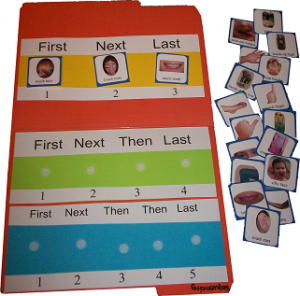
Sequencing Board File Folder Game
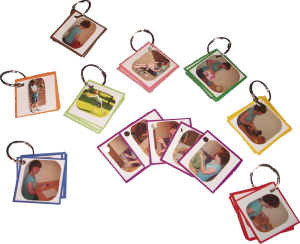
Step-by-Step Activity Cards for Sequencing
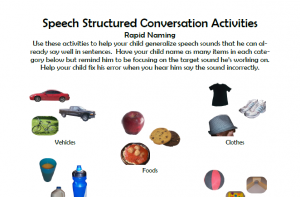
Structured Conversation Carry-Over Pack (includes prompts like, “tell me about the last time you…”)

About the Author: Carrie Clark, MA CCC-SLP
Hi, I’m Carrie! I’m a speech-language pathologist from Columbia, Missouri, USA. I’ve worked with children and teenagers of all ages in schools, preschools, and even my own private practice. I love digging through the research on speech and language topics and breaking it down into step-by-step plans for my followers.
Fun Fact: I’m addicted to using visual aids. I literally can’t stop myself. I have visual aids for myself to remember things. I have visual aids all over the house for my kids to help them with all aspects of their day as well. I make them for my clients all of the time. Whenever my sons’ school contacts me about a struggle that one of my kids is having, my immediate response is usually “can I make you a visual aid for that???”
Connect with Me:
Carrie’s Best Tools to Simplify your Life:
You have a lot on your plate. Let me help with that!
I’ve put together my best resources here. Whether you’re streamlining your job as a speech-language professional, helping your child with his communication challenges, or trying to meet the diverse needs of your students, I’ve got you covered.
Choose the resource that you need most right now:

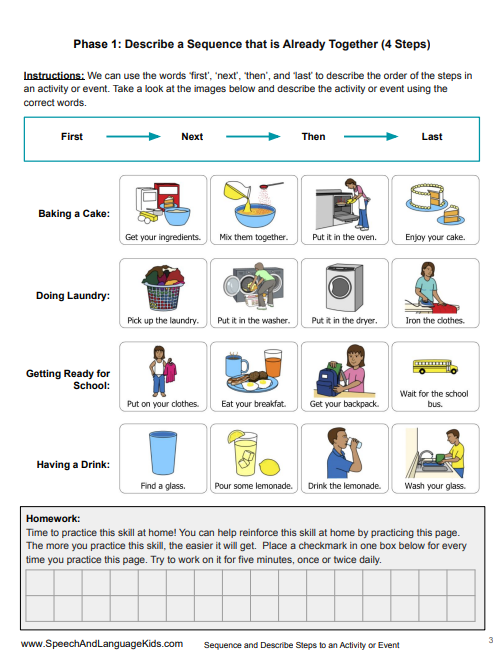
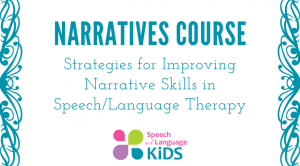






Hi,
I’m unable to access the free download. The links there are just to sign up for you mailing list. I also can’t access the free sequencing boards, it just sends me to the image on the page. Thanks
email me at Carrie@Speechandlanguagekids.com and we’ll make sure you get whatever you need. On the main site, you do have to enter your email address to get the freebies. That’s how they’re delivered. You can unsubscribe at any time.
I cannot find the link for the game. I am already on the e mail list, but signed up again and still could not find the link for the game. Thank you!
Please email me at Carrie@Speechandlanguagekids.com and we’ll get you set up
Hi.
I cannot find the link for the game. Hope to hear from you soon!
Email us at Carrie@Speechandlanguagekids.com and let us know what you need. The button may not be there if your network/school is blocking it.
Hi,
I’m unable to access the free download. The links there are just to sign up for you mailing list. I also can’t access the free sequencing boards, it just sends me to the image on the page. Thanks
Hi, Amna-
Here is the link for the Sequencing Game.
Hi,
Thanks for your clear explanations of how to develop a wide range of foundational skills on your blog.
I am looking for some research evidence regarding ages and stages of picture sequencing – do you have any articles or books that you could recommend (e.g. the rationale behind why 4 / 5 year olds can be given 4 step sequences versus 6 step etc)
Thanks in advance
Christine
Hi Christine, I am looking for the same info – normative data on what level of sequencing a typical child is expected to do. Did you find it?
I would also like to see this information. What age do children typically master picture sequencing?
I am looking for the same info. I can’t seem to find a reference on normative data
Hello!
this is amazing! thank you for sharing! I’m having a good time lesson with my kiddos!
That’s great to hear, Katerine! We appreciate you letting us know.
Hi I am unable to access the free download.
Kindly advise
Hi, Juliet-Please check your inbox, as we have emailed you the requested resource.
These are really fun ideas! Sequencing can be so dry if not made a bit more exciting I feel!